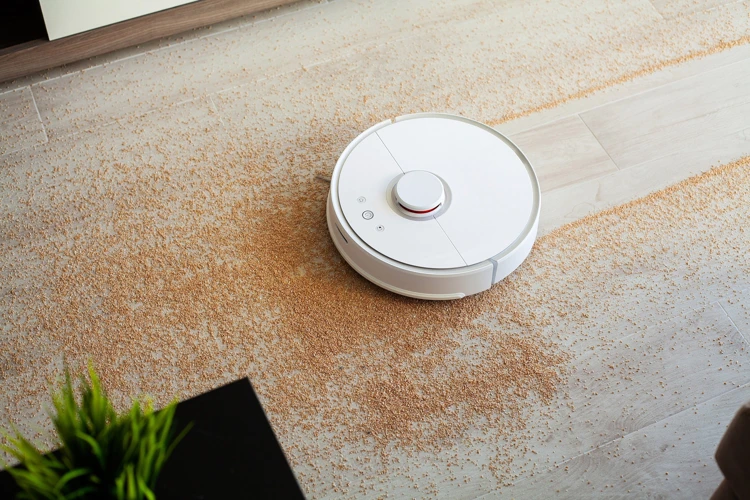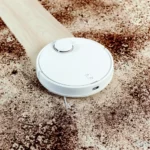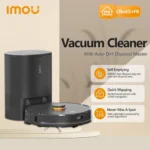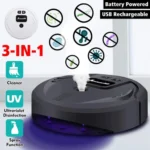Have you ever found yourself scratching your head and wondering why your smart vacuum cleaner isn’t doing its job properly? You may have invested in the latest technology with a myriad of advanced features, yet it still fails to pick up dirt and dust as it’s supposed to. Before you throw in the towel and call customer support, let’s explore some of the possible reasons why your vacuum cleaner is underperforming. From dirty filters and brush roll problems to low suction power and software issues, we’ve got you covered with step-by-step solutions to get your vacuum back in tip-top shape. So buckle up and get ready to discover the secrets to a cleaner home!
The Filter is Dirty or Clogged
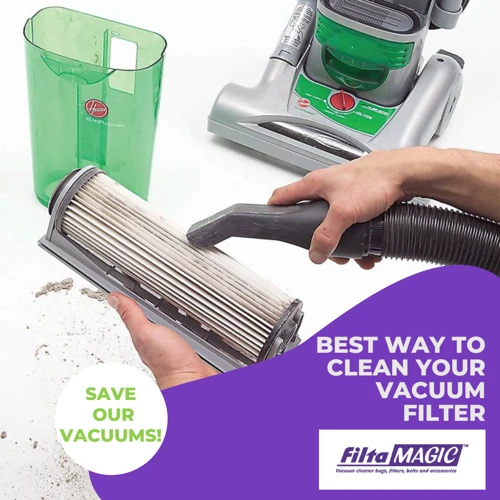
Have you ever noticed that your smart vacuum cleaner isn’t picking up dirt even though it’s running? The culprit could be a dirty or clogged filter. Over time, the filter can become clogged with dust and debris, which can cause problems with your vacuum’s suction power. This is a common issue that can be easily fixed with some basic maintenance. In this section, we’ll explore the possible reasons why your filter might be dirty or clogged and what you can do to fix it. If you’re looking for more troubleshooting tips for your smart vacuum, check out our smart vacuum troubleshooting tips article.
Blocked Airflow
One reason why your smart vacuum cleaner may not be picking up dirt is because of blocked airflow. This occurs when debris, pet hair or fibers clog up the filters or the dustbin. Blocked airflow can heavily impact the performance of your smart vacuum cleaner and cause it to leave dirt behind.
If your smart vacuum cleaner has blocked airflow, you may notice that it doesn’t suck up debris like it once used to or pushes it around instead. To fix this, start by turning off the vacuum cleaner and unplugging it from the outlet. Then, remove the filter and clean it according to the manufacturer’s instructions. This may include washing it, shaking it out, or tapping it to remove the dust and debris.
Next, empty the dustbin and remove any clogs from the air pathway using a soft brush or a cleaning tool. If the air pathway is particularly stubborn, use a wire hanger to fish out any debris that may have become stuck. Once everything is clean, reassemble your smart vacuum cleaner and restart it.
Keeping your vacuum cleaner’s filters clean can prevent blocked airflow issues in the future. Make sure to change your filters regularly, as advised by the manufacturer. Additionally, empty the dustbin frequently to avoid the buildup of dust and debris which may cause the vacuum cleaner to overwork.
If you’d like to read more about common smart vacuum cleaner issues, have a look at our previous article on common smart vacuum cleaner mistakes. You can also learn how to clean the brushroll in our article on cleaning the brushroll on your smart vacuum cleaner. And don’t forget to check out our guide on how to perform a suction test in our article “Smart Vacuum Suction Check”.
Full Dustbin
One of the main reasons why your smart vacuum cleaner might not be picking up dirt could be due to a full dustbin. When the dustbin of your smart vacuum cleaner is full, it restricts the airflow, causing the suction power to decrease significantly. This can lead to poor cleaning performance, and it can even cause the vacuum cleaner to shut down.
To avoid this issue, it is imperative that you check the dustbin of your smart vacuum cleaner on a regular basis. Here are some of the signs that indicate that your dustbin is full:
- Reduced suction power: When the suction power of your vacuum cleaner reduces significantly, it could be due to a full dustbin.
- Visible dirt: If you see dirt or debris on your floors even after your robot vacuum has cleaned, it could be an indication of a full dustbin.
- Foul odor: A foul odor emanating from your vacuum cleaner could indicate that there is dirt or debris stuck in the dustbin.
If you notice any of these signs, it’s time to empty the dustbin. To do this, follow these steps:
- Locate the dustbin: The dustbin is usually located at the back or bottom of the vacuum cleaner. Refer to your user manual for specific instructions.
- Remove the dustbin: Once you’ve located the dustbin, remove it from the vacuum cleaner.
- Empty the dustbin: Empty the dustbin into a trash can. If the dustbin is full, you might want to use gloves to avoid getting dirt all over your hands.
- Clean the dustbin: Once you’ve emptied the dustbin, clean it with a damp cloth to remove any remaining dirt or debris.
- Replace the dustbin: Once the dustbin is clean and dry, replace it back into the vacuum cleaner.
By following these simple steps, you can avoid a full dustbin, which can inhibit the cleaning performance of your smart vacuum cleaner. Remember, regular maintenance is crucial for optimal performance.
Brush Roll Problems
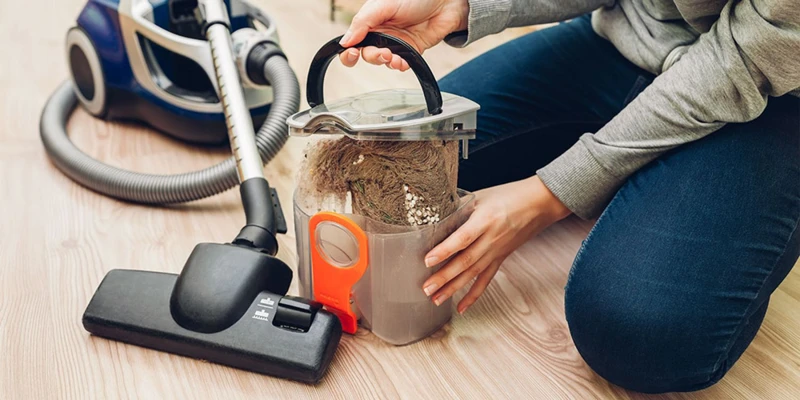
Have you ever noticed that your smart vacuum cleaner seems to be missing patches of dirt on your floors? It might be frustrating to see the cleaning job done incompletely, especially after investing in an appliance that promises to make your cleaning routine effortless. One of the reasons behind this issue could be problems with the brush roll in your device. The brush roll plays a crucial role in picking up dirt and debris from your floors. If it’s not functioning properly, your robot vacuum may leave more dirt behind than it picks up. Let’s take a closer look at some of the brush roll problems that may be preventing your smart vacuum cleaner from doing its job effectively.
Entanglement
One of the most common reasons why your smart vacuum cleaner may not be picking up dirt is due to an issue with the brush roll. One problem specifically is entanglement of the brush roll.
What is brush roll entanglement?
Brush roll entanglement occurs when hair, thread, or other debris becomes tangled around the brush roll. This can slow down or completely stop the brush roll from spinning, resulting in poor cleaning performance.
How to check for brush roll entanglement?
To check for brush roll entanglement, turn off and unplug the vacuum cleaner. Examine the brush roll for any visible debris or tangles that may be causing it to stop spinning.
How to fix brush roll entanglement?
To fix brush roll entanglement, use scissors or a brush to carefully remove any hair, thread, or debris that has become tangled around the brush roll. It’s important to be gentle and avoid pulling too hard on the debris, as this could result in damage to the brush roll.
How to prevent brush roll entanglement?
To prevent brush roll entanglement, it’s important to regularly clean the brush roll and remove any hair, thread or debris that may have become tangled around it. Some vacuum cleaners come with special tools designed to make this process easier.
To summarize, brush roll entanglement is a common issue that can cause your smart vacuum cleaner to not pick up dirt properly. Regularly checking and cleaning your brush roll can help to prevent this problem from occurring.
Damaged or Worn Brushes
Over time, the brushes on your smart vacuum cleaner can get damaged or worn out, which can greatly impact its ability to pick up dirt efficiently. The brush roll is responsible for agitating the carpet fibers, dislodging embedded dirt and debris, and flinging it into the suction path of the vacuum. If the brushes are not working as they should, this process will not happen, and the dirt will remain on your floors.
What are the signs of damaged or worn brushes?
1. The vacuum cleaner is leaving behind significant amounts of debris, even after several cleaning sessions.
2. The vacuum cleaner is making strange noises when in use.
3. You can see visible damage to the brushes, such as frayed bristles, bent or broken parts, or uneven wear.
If you notice any of these signs, it is possible that you have damaged or worn brushes that need to be replaced. Here are some common reasons why brushes can become damaged or worn:
| Reasons for Damaged or Worn Brushes | Solution |
|---|---|
| The vacuum cleaner is used on a regular basis. | Replace the brush roll every 6-12 months, depending on use and manufacturer recommendations. |
| The vacuum cleaner is used on tough surfaces, such as concrete. | Consider using a different vacuum cleaner or a specialized brush roll for that surface. |
| The vacuum cleaner encounters large or hard objects that damage the brushes. | Clean the brush roll and replace any damaged parts as soon as possible. |
How to prevent or minimize brush roll damage?
1. Regularly check the condition of the brushes for any visible wear and tear, and promptly replace them if necessary.
2. Regularly clean the brush roll of any tangled hair, fibers, or other debris that can affect its performance.
3. Choose the right brush roll for your vacuum cleaner and the surfaces you are cleaning.
By taking care of your smart vacuum cleaner, you can ensure that it remains in top condition and continues to provide efficient cleaning performance for years to come.
Low Suction Power
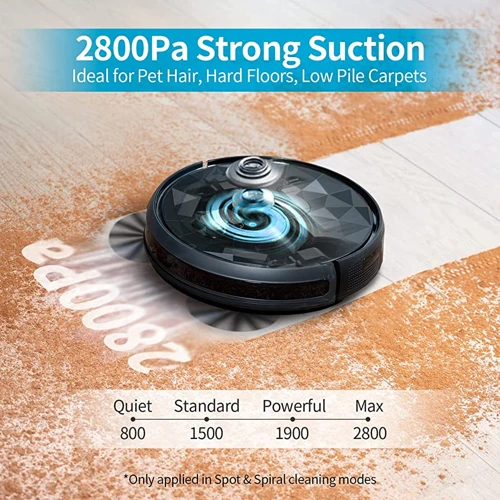
You may have noticed that your smart vacuum cleaner is leaving behind dirt and debris. It’s cleaning, but not as effectively as it used to – this can be frustrating. If you’re experiencing this issue, the culprit behind the lack of cleaning power might be low suction. Low suction power can occur due to a variety of reasons, which we will examine in this section. Sometimes it’s an easy fix, and other times it might require more extensive troubleshooting. Either way, understanding the reasons behind low suction power can help you get your smart vacuum cleaner back in peak performance.
Weak Battery
One of the possible reasons why your smart vacuum cleaner might not pick up dirt effectively is due to a weak battery. A weak battery won’t last as long as a fully charged battery, which can impact the suction power of your machine.
Here are some signs that your vacuum cleaner’s battery might be weak:
- The vacuum cleaner shuts off or doesn’t turn on at all
- The suction power of the vacuum cleaner is low
- The vacuum cleaner runs for a shorter period than it used to on a single charge
If you suspect that your vacuum cleaner’s battery is weak, the first thing you should do is check the warranty to see if the battery is covered. If it is, contact the manufacturer to request a replacement battery.
If the battery is not covered by warranty, you may need to purchase a new one. Before doing so, make sure the vacuum cleaner’s battery is the actual problem by testing it. You can do this by charging the battery fully and then using it to clean a small area. If the vacuum cleaner doesn’t have much suction power, even with a fully charged battery, there’s likely an issue with the battery.
In some cases, you may be able to extend the lifespan of your battery by following a few tips:
- Store the battery at room temperature or cooler
- Charge the battery fully before use and don’t overcharge it
- Use the vacuum cleaner frequently to keep the battery active
- Replace the battery when it starts to lose its charge capacity
By doing these things, you can help ensure that your vacuum cleaner’s battery lasts as long as possible and provides optimal suction power.
Clogged Hose
If you’re experiencing low suction power, it may be a result of a clogged hose. Over time, pet hair, dust, debris, and other particles can accumulate in your smart vacuum cleaner’s hose, leading to weak suction and a poorly cleaned floor. Here are a few tips to unclog your vacuum cleaner’s hose:
- Inspect the hose: First, you’ll want to unplug your vacuum cleaner and detach the hose from the machine. Inspect the hose thoroughly for any blockages, such as pet hair or small toys. Use a flashlight to check the interior of the hose to see if there are any blockages that are not visible from the outside.
- Use a long object: If there’s a visible clog, grab a long object such as a broomstick or coat hanger and gently push it through the hose to dislodge the blockage. Avoid using sharp objects that may damage the hose.
- Run water through the hose: Another useful technique is to run water through the hose. Hold one end of the hose under a running faucet and let the water run through it. This will help flush out any clogs that you couldn’t remove with a long object.
- Clean the hose: Once you’ve removed the clog, take some time to clean the hose thoroughly. You can use a mild detergent and warm water to rinse out the inside of the hose. Be careful not to twist or bend the hose too much, as this can cause damage.
Keep in mind that prevention is the best way to avoid clogs in your vacuum cleaner’s hose. Empty the dustbin frequently and check the hose for visible debris after every use. By taking these steps, you’ll be able to maintain the proper suction power of your vacuum cleaner, keeping your floors clean and dust-free.
Software or Hardware Issues
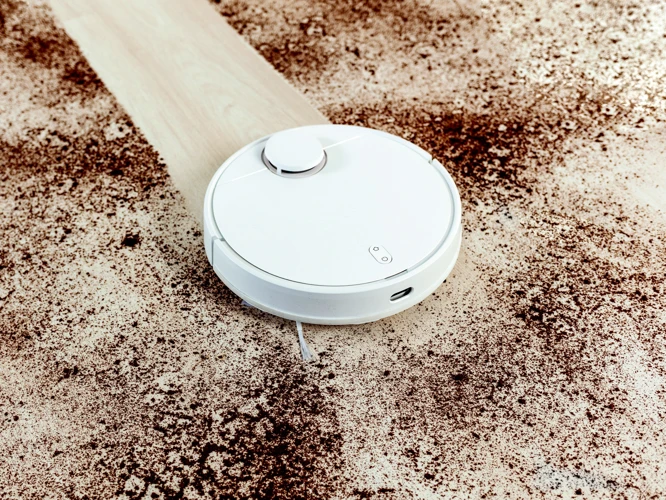
Have you checked your filter, dustbin, and brush roll but your smart vacuum still isn’t picking up dirt? It’s possible that the issue lies with the software or hardware. Don’t panic just yet, as there are a few things you can check before calling in a repairman. Let’s dive into some possible causes of perplexing software or hardware issues that may be hindering your vacuum’s performance.
Connection Problems
One of the reasons why your smart vacuum cleaner may not be picking up dirt is due to connection problems. If the vacuum is not connecting to its charging dock or the Wi-Fi network, it may not function properly. Here are some things to check if you suspect that your vacuum has a connection issue:
- Check for Wi-Fi connectivity: If your smart vacuum is supposed to be connected to your Wi-Fi network, make sure it is connected and receiving a strong signal. A weak signal or disconnected network can cause the vacuum to malfunction.
- Verify the charging dock is connected: If the vacuum isn’t connecting to its charging dock, make sure the dock is properly connected to a power source and the vacuum’s charging contacts are clean.
- Reset the vacuum: Sometimes a simple reset can fix connection issues. Try resetting your vacuum according to its instructions.
- Contact customer support: If your vacuum’s connection problems persist, it may indicate a larger hardware issue. Contact the manufacturer’s customer support for help troubleshooting the issue further.
It’s important to regularly check for and address any connection issues with your smart vacuum as it can lead to larger problems with overall function and performance.
Motor Malfunction
One of the possible reasons your smart vacuum cleaner might be failing to pick up dirt is a malfunctioning motor. The motor is the heart of any vacuum cleaner, including the smart ones. It’s responsible for powering the fan that creates the suction that draws in the dirt. If the motor is not working correctly, the suction will be weak or non-existent, and the vacuum cleaner won’t be able to pick up any dirt or debris.
Here are some signs that suggest your vacuum cleaner’s motor is malfunctioning:
- Burning smell: If you detect a burning smell coming from your vacuum cleaner, it’s a sign that the motor is overheating. This could be due to a clogged air filter or excessive use of the vacuum cleaner.
- Noise: A loud noise or an unusual sound, such as whistling or rattling, coming from your vacuum cleaner could indicate a problem with the motor bearings or fan blade.
- Low suction power: If the suction power of your smart vacuum cleaner has decreased significantly, it could be due to a malfunctioning motor.
- Failure to start: If your vacuum cleaner fails to start or stops working suddenly, the motor might be at fault.
If you notice any of these signs, it’s essential to address the problem promptly. Try these steps to troubleshoot the motor malfunction:
- Check the power supply: Make sure your vacuum cleaner is plugged in properly and the outlet is functioning correctly. If the problem persists, unplug the vacuum cleaner and try another outlet.
- Clean or replace the air filter: A clogged air filter can cause the motor to overheat and stop working. Clean the filter or replace it if it’s damaged.
- Inspect the fan blades: If the fan blades are damaged or obstructed by debris, the motor may not work correctly. Remove any debris and examine the blades for any signs of damage.
- Consult a professional: If you’re unable to troubleshoot the motor malfunction, it’s best to contact a professional technician to repair or replace the motor.
Remember to follow the manufacturer’s instructions for maintenance and cleaning of your smart vacuum cleaner. With proper care, your vacuum cleaner’s motor will last longer and perform better.
Maintenance Tips
To ensure that your smart vacuum cleaner is always functioning at an optimal level, proper maintenance is crucial. Here are some essential tips to help you prolong the life of your device:
Clean the Filter Regularly: As mentioned earlier, the filter can get clogged, leading to reduced suction power. To avoid this, make sure to clean the filter regularly, preferably after each use. Some filters are washable, while others require replacement when they get dirty.
Clear the Dustbin: If your vacuum cleaner’s dustbin is full, it won’t be able to pick up dirt effectively. Make sure to empty it after each use or when it’s about three-quarters full.
Clean the Brush Roll: The brush roll can accumulate hair and debris, causing it to stop working effectively. To avoid this, make sure to clean the brush roll regularly, preferably after each use. You can use a pair of scissors to cut off any entangled hair or strings.
Check the Brushes: Over time, the brushes can wear out or get damaged, leading to reduced cleaning efficiency. Check the brushes regularly and replace them if you notice any signs of wear or damage.
Inspect the Suction Inlet and Hose: If the suction inlet or hose is blocked, it can significantly reduce the suction power of your vacuum cleaner. Inspect these parts regularly and remove any blockages that you find.
Update the Software: Occasionally, the manufacturer may release updated software for your smart vacuum cleaner. Make sure to update the software regularly to improve its performance and fix any bugs.
Charge the Battery Properly: If your smart vacuum cleaner runs on battery power, make sure to charge it properly. Overcharging or undercharging the battery can reduce its lifespan or even cause it to malfunction.
By following these maintenance tips, you can ensure that your smart vacuum cleaner always performs at its best, picking up dirt effectively, and saving you time and effort.
Conclusion
After exploring the possible reasons why your smart vacuum cleaner isn’t picking up dirt, you might feel overwhelmed and frustrated. It can be perplexing to troubleshoot the problem, especially if you are not technically-savvy. However, don’t despair. In most cases, with a bit of patience and effort, you can resolve the issue and enjoy a sparkling clean house.
Remember that your smart vacuum cleaner is a complex machine that includes various parts, such as filters, brushes, suction mechanisms, and software components. Each of these parts can malfunction or deteriorate over time, leading to performance issues. You might have to clean, replace, or repair some of them to restore your device to its best functioning.
To avoid encountering such problems in the future, make sure to follow the maintenance tips we provided earlier in this article. Regularly clean the filters, empty the dustbin, remove hair from the brush roll, and inspect the battery and motor. Also, pay attention to any strange noises or behaviors of your vacuum, as they might indicate a problem that needs addressing.
Lastly, don’t hesitate to contact the manufacturer of your smart vacuum cleaner or a professional technician if you feel overwhelmed or uncertain about the troubleshooting process. They can provide you with customized advice and guidance based on your specific model and issues.
In summary, a smart vacuum cleaner that doesn’t pick up dirt can be frustrating, but it’s not necessarily the end of the world. By understanding the common causes and solutions, you can take steps to fix the problem and prevent it from happening again. Remember to stay patient, vigilant, and proactive in maintaining your device, and you’ll enjoy a hassle-free cleaning experience.
Frequently Asked Questions
Why is my smart vacuum cleaner not picking up dirt?
There are several reasons why your smart vacuum cleaner may not be picking up dirt, such as dirty filters, brush roll problems, low suction power, or software/hardware issues.
How do I know if the filter is dirty or clogged?
You can tell if the filter is dirty or clogged if you notice reduced suction power or if the vacuum emits a dusty smell. Check the filter and clean or replace it as necessary.
What causes blocked airflow in my smart vacuum cleaner?
Blocked airflow can be caused by a dirty filter, a full dustbin, or obstructions in the hose or brush roll. Check for these issues and clear any blockages.
How often should I clean or replace the filter in my smart vacuum cleaner?
It’s recommended to clean or replace the filter in your smart vacuum cleaner every 3-6 months, depending on usage.
What can cause entanglement in the brush roll?
Hair, string, and other debris can get caught in the brush roll, causing entanglement. Regularly cleaning the brush roll can prevent this issue.
How do I know if the brush roll on my smart vacuum cleaner is damaged or worn?
You may notice a decrease in performance or strange noises coming from the brush roll if it’s damaged or worn. Check the brush roll and replace it if necessary.
Why is my smart vacuum cleaner experiencing low suction power?
Low suction power can be caused by a weak battery, a clogged hose or filter, or a damaged motor. Check for these issues and address them accordingly.
How can I prolong the battery life of my smart vacuum cleaner?
To prolong the battery life of your smart vacuum cleaner, avoid leaving it in a fully charged or fully drained state for extended periods of time. It’s also important to clean the filters and brush roll regularly to prevent strain on the motor and battery.
What can I do if my smart vacuum cleaner is experiencing software or hardware issues?
If you’re experiencing software or hardware issues with your smart vacuum cleaner, try resetting it or contacting the manufacturer for troubleshooting tips. If the issue persists, it may require professional repair.
How often should I perform maintenance on my smart vacuum cleaner?
Perform routine maintenance on your smart vacuum cleaner, such as cleaning the filter and brush roll, after every use. Deep cleaning and inspection of the motor, battery, and other components should be done every few months.
